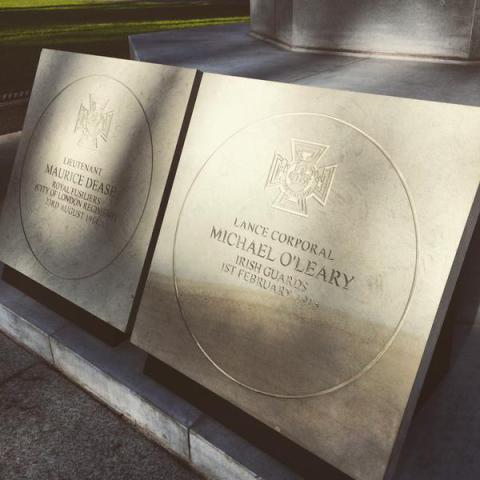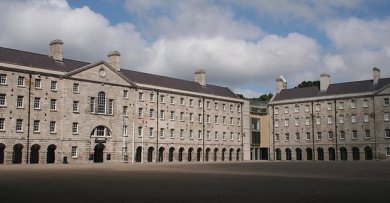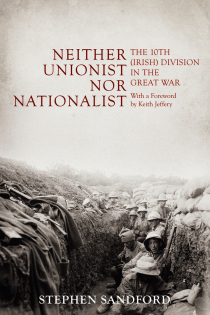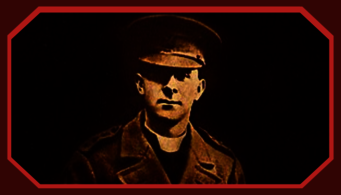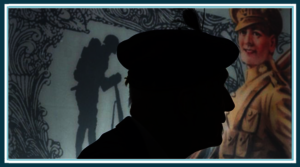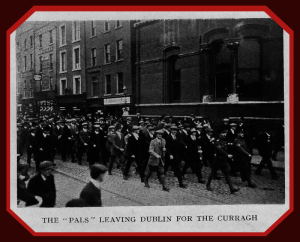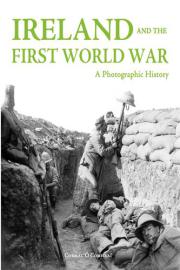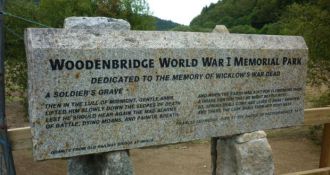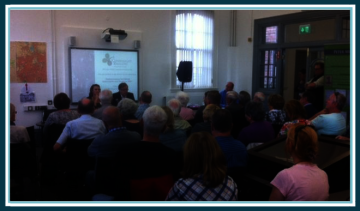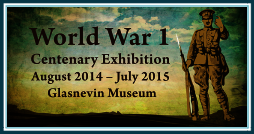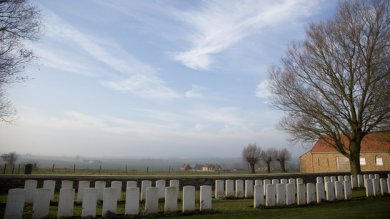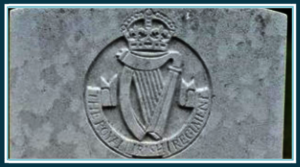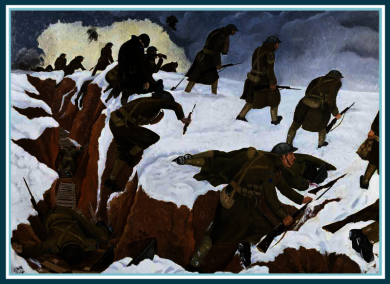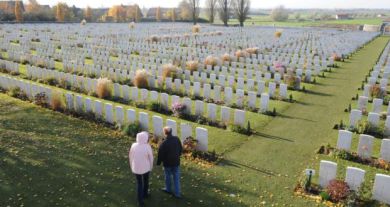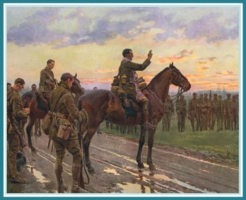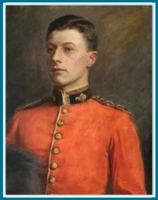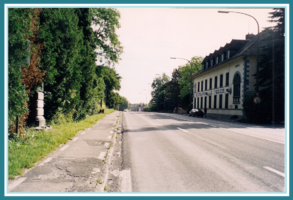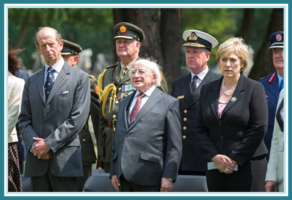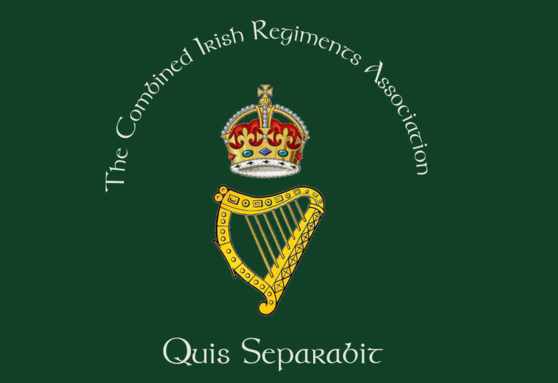
in the news.
We shall be adding here selected news stories from the National and International Press.
To read further details, click on the underlined linked webpage, which will take you to an external website in each case.
Major conference announced for Gallipoli centenary.
"The centenary of the Gallipoli landings in April will be marked in Ireland with a conference hosted by the annual Hay Literary Festival in Kells and by RTÉ Radio 1’s The History Show.
The event, which will be funded in part by the Reconciliation Fund of the Department of Foreign Affairs, will take place on the weekend of the centenary of the landings.
The three-day event will commence on Friday, April 24th, with the delivery of the Francis Ledwidge Memorial Lecture by the Irish first World War historian Philip Orr, author of Field of Bones: An Irish Division at Gallipoli..."
The life and troubled times of an authentic Irish war hero.
"On February 1st 1915, the Irish Guards were attacking a stretch of the La Bassée canal in northern France near the Belgian border.
Lance Corporal Michael O’Leary, a 24-year-old ex-policeman from Macroom, Co Cork, ran forward in front of his men, mounted a railway embankment and shot five members of a German machine-gun crew at the barricade.
He then attacked another machine gun crew 60 yards further on. He killed three more Germans. The other two crew surrendered.
His comrades looked on in amazement. One said afterwards: “O’Leary came back from the killing as cool as if he had been for a walk in the park”.
For this near suicidal act of bravery, O’Leary was awarded the Victoria Cross (VC) and promoted to sergeant..."
Rare photographs of Gallipoli in exhibition.
"Photographs of the Gallipoli campaign which have never been made public have gone on display at the National Museum of Ireland in Collins Baracks.
The photographs were taken by Andrew Horne, a doctor from Ballinasloe, Co Galway, who served in the Royal Army Medical Corps during the first World War.
His album shows shells exploding on the beaches of Gallipoli and a rare photograph of the river Clyde, with a converted coaler which effectively became a coffin ship for the Royal Dublin Fusiliers and the Royal Munster Fusiliers during the Gallipoli landings on April 25th, 1915..."
Recovered Voices - Stories of the Irish at War.
"About 21,000 Irishmen were already serving in the British Army when war broke out in 1914. NMI’s new exhibition ‘Recovered Voices’ explores what happened to them, and the other 47,000 who joined in the first few years of the war.
From the lush green fields of France in the summer of 1914, through that first Christmas in the trenches, to the sun dried beaches of Turkey in 1915, this exciting new exhibition unveils the complexity of Ireland’s part in World War One.
Detailing the stories of 21 Irishmen and women, the exhibition uses original objects and interactive material to illustrate the human impact of the war on their lives."
Descendants of Gallipoli veterans invited to join 100th anniversary commemorations in London.
"An event to commemorate the Gallipoli Campaign was announced at IWM London by Culture Secretary Sajid Javid.
Descendants of those who served at Gallipoli in 1915 have been asked to come forward to take part in a ceremony in London to mark the 100th anniversary of the start of the campaign.
The event will be held on Saturday 25 April 2015 at the Cenotaph on Whitehall.
Descendants of those who fought at Gallipoli can apply for free tickets to either watch from a reserved area or to join a march past the Cenotaph as part of the ceremony. The general public can also attend.
The event is being led by the UK Government in collaboration with the Australian and New Zealand High Commissions. There will also be a Dawn Service at Hyde Park Corner and a service at Westminster Abbey on 25 April."
Neither Unionist nor Nationalist: The 10th (Irish) Division in the Great War 1914-1918.
"The first major history of the 10th (Irish) Division since 1918 based on extensive archival research and access to previously unavailable documentary material. Unprecedented analysis and cross referencing of the 10th Division’s regimental rolls, Commonwealth War Graves Records, census returns, obituaries and newspaper reports yields a new understanding of its composition and combat performance and sheds new light on the Gallipoli disaster and the campaign in Palestine."
Fr Francis Gleeson - The Irish saint of the trenches.
"Francis Gleeson was one of the thousands of Irishmen who served in the First World War. But he did not go to fight. He provided spiritual and physical comfort to the second battalion of the Royal Munster Fusiliers. He was their chaplain, a role iconically portrayed in the painting, The Last General Absolution of the Munsters at Rue du Bois.
'The scenes of enthusiasm are extraordinary,' he wrote on May 8, 1915, the eve of the Battle of Aubers Ridge. 'I ride on my horse. Give absolution to [the] battalion during rest in [the] road...The men all sing hymns, ‘Hail Glorious St Patrick’. I go further up — near the trenches, and bid goodbye to all. So sad.'
Many of the men, recruited from Kerry, Cork, Limerick, and Clare, were killed. The roll call was described as 'the saddest imaginable; by Fr Gleeson in his diary, which, along with his correspondences, is housed at the Dublin Diocesan Archives. 'Some had lost brothers, others cousins, but all had lost good and faithful comrades...'
'What a day for all the Munsters,' he wrote in his diary on May 9. 'We lose at least 350 men, between killed and wounded and missing. Spent all night trying to console, aid, and remove the wounded. It was ghastly to see them lying there in the cold, cheerless outhouses, on bare stretchers with no blankets to cover their freezing limbs... Hundreds lying out in cold air all night at Windy Corner. No ambulances coming. They came at last — at daylight.'..."
Exhibition opens on Ireland’s involvement in the First World War.
"An exhibition that seeks to portray Ireland and the first World War with all its complexities and contradictions has opened at the National Library.
The exhibition will run for the duration of the centenary of the war until 2018 and will be updated to reflect centenary events as they arise. It features the lives of four people, each of whom represented a strand of Irish life at the time.
Michael O’Leary became a folk hero and a poster child, figuratively and literally, for the British war effort when he won a Victorian Cross in 1915 after storming a German machine gun nest.
His family were small farmers from Co Cork and he represents the thousands of Irish Catholics who signed up to the British Army..."
New exhibition remembers rugby players killed in war.
"An exhibition to remember 39 players from Lansdowne rugby club who did not return from fighting in the the first World War will open this evening (11th November).
The so-called posh pals were mostly drawn from the middle class and educated sections of Dublin society.
They signed up in their hundreds after a call from the IRFU president Frank Browining in August 1914...."
Ireland And The First World War: A Photograhic History.
"Dismissively called 'Cogadh an Dá Ghall' (The War of the Two Foreigners) by some Irish speakers, the First World War saw the mobilisation of hundreds of thousands of Irish people as soldiers, sailors and nurses. The war brought massive suffering, heroism, personal liberation, profit and economic hardship, and also provided the conditions necessary for a rebellion against British rule. Using striking photographs from a wide range of sources, this book shows the experiences of the Irish at home and abroad as the 'Great War' raged across Europe."
Ireland's Great War.
(Irish Times - Ireland's Great War)
(Irish Times - Century First World War)
Several articles reviewing contributions during the First World War.
"...It is now generally accepted that the number of Irishmen who left this country as members of the army, navy, as reservists or as volunteers between 1914 and 1918, was roughly 210,000. This does not include the many Irish-born soldiers who enlisted (or were conscripted) in Britain, Australia, New Zealand, USA, Canada, South Africa and elsewhere.
There is far less consensus on how many members of that cohort died. The Irish National War Memorial Records (INWMR), compiled in the early 1920s, lists 49,647 Irish fatalities, North and South. However, included in this register are the names of more than 11,000 men born outside Ireland. Most of these are British soldiers who served in Irish units like the Dublin Fusiliers, the Munsters, the Inniskillings or the Connaught Rangers...."
Legacy of Connaught Rangers remembered.
6th Connaught Rangers Research Project.
"The part played by Irish nationalists from Belfast in the Connaught Rangers during the First World War has been marked by a special exhibition.
A collection of photographs, letters and memorabilia has been put on display at the Falls Road library in west Belfast.
Once, such an exhibition would have raised eyebrows but now the display, called The Legacy of Belfast Nationalists and the Great War, has been put on as part of the West Belfast festival, Féile an Phobail.
The collection has been put together by volunteers from the 6th Connaught Rangers research group who aim to record the role Belfast men played in the regiment..."
Exhibition in the Glasnevin Cemetery Museum.
"In May 2014, Glasnevin Cemetery Museum appealed to members of the public to come forward with artefacts and heirlooms relating to Ireland’s involvement in the First World War. The response was overwhelming and the range of objects and stories brought out into public for the first time gave a unique insight into the history of Ireland during that period.
A member of the Irish parliament lays a wreath at a Flanders peace park on the centenary of the Battle of Ypres.
"Frank Feighan, from the governing Fine Gael party, laid the green laurel wreath at the Island of Ireland Peace Park on Messines Ridge in Belgium.
About 70,000 killed, injured or missing from Irish-raised regiments are commemorated there.
Mr Feighan said the men had been "airbrushed out of history".
He said: "I feel that consecutive Irish governments airbrushed these men out of history and they had to grow up in a state which didn't dare talk about the bravery, the suffering, the service that they gave, history forgot them but now is an appropriate time to remember.
"I felt that this was a history that the vast majority of people in the Republic had forgotten about and now that we have matured it is now very appropriate to remember the thousands of young men from both traditions across the island of Ireland who died..."
The Battle of Le Pilly.
"Somewhere in the chalky uplands of French Flanders lie the bodies of 162 Irishmen who died 100 years ago this month in a battle hardly anybody remembers.
Millions of men died in the First World War and have no known grave, but it is rare, despite all the unspeakable carnage, that the dead of a whole regiment would disappear without a trace.
The 2nd Battalion of the Royal Irish Regiment had performed a redoubtable rearguard action at the Belgium town of Mons on August 23rd, 1914, which saved the British army from disaster, but they suffered a catastrophe at the French hamlet of Le Pilly just six weeks later.
The battle was part of the “Race to the Sea”, one of the First World War’s great misnomers. There was no race to the sea, just the Allies and the Germans who sought to attack each other’s flanks until the North Sea intervened...."
The Art of World War One in 52 Paintings.
"Since the First World War was fought at a time of major changes in artistic movements, the period is particularly rich with a variety of art styles. The development of photography in the late 19th Century had pushed painting particularly away from realism, into a broad group called expressionism. The movement sought to present the world subjectively, radically distorting it for emotional effect – famous artists such as Edvard Munch, Paul Klee and Wassilly Kandinsky were all expressionists.
The effect of the movement meeting the cataclysm of the war saw expressionist painting directly related to the fighting appear across Europe. In Britain, some of the more prominent works related to the war abandoned realistic styles and combined with the trend of Italian Futurism and Cubism to create Vorticism. Industrial warfare, shattered landscapes and the horrors of the battlefield suited modernist styles, and art often escaped earlier realism.."
First World War Dead remembered at Ypres Ceremony.
"The 600,000 soldiers who died in the killing fields of Flanders were honoured last night (17th October) in a huge display of lights 85km long.
The Ypres Salient - the area around Ypres in northern Belgium which was the scene of some of the worst fighting in the first World War - covers an area smaller than Co Louth. The dead of 30 nations are buried there, including Ireland which lost at least 9,000 men in the fighting.
Some 8,400 torch bearers formed a human chain from the coast at Nieuwpoort to the memorial to the missing at Ploegsteert where Belgium’s King Philippe and his wife Mathilde lit a candle for those who died at an event to mark the beginning of the first Battle of Ypres.
A light was placed on all of the 12,000 known graves in Tyne Cot cemetery, the largest British military cemetery in the world, and the one which commemorates the dead from the Battle of Passchendaele.
Ireland was represented by the Irish ambassador to Belgium Eamonn Mac Aodha and the chairman of the British Irish Parliamentary Assembly Frank Feighan. They were joined by the deputy British ambassador Katrina Johnson and the head of office of the Northern Ireland executive office Gerry Mulligan..."
Irish government invited to Remembrance Sunday at the Cenotaph.
"The Irish government has accepted an invitation to lay a wreath at the Cenotaph in London on Remembrance Sunday next month.
The UK government said it recognised 'the immense contribution and shared sacrifice' of thousands of Irish people who served in British forces.
The Irish ambassador to the UK, Daniel Mulhall, said he was pleased to accept the invitation...."
Mapping Limerick's casualties during the First World War.
"How do you communicate the scale of Limerick’s loss during the First World War? This was one of the most traumatic events in Limerick’s recent history, over 1,000 violent deaths which occurred out of sight of relatives and friends. We have sought to visually represent the scale of the death toll through a series of interactive maps...."
Honouring Ireland’s war dead – by counting them accurately at last.
"Irish Army veteran Tom Burnell is a man with a mission – to establish the true death toll of Irish soldiers in the First World War, which he believes is 50 per cent higher than the official figure.
'Several years ago I set out to rewrite Ireland’s memorial records. The memorial records, which were compiled in 1923, list the names of 49,400 Irishmen who died in the First World War. That figure has been accepted as definitive by many people, especially politicians, though it is wrong....'
The Last General Absolution of the Munsters.
"The publication...of an image of the lost First World War painting, 'The Last General Absolution of the Munsters at Rue du Bois', has rekindled memories among several older Irish Times readers.
The fate of the original painting, by Italian-born artist, Fortunino Matania, remains unknown but prints of the painting, published in weekly newspapers a century ago, have survived.
The painting depicts soldiers of the 2nd Battalion, Royal Munster Fusiliers regiment receiving “general absolution” from their chaplain, Tipperary-born Fr Francis Gleeson, depicted in the painting on horseback, on the eve of battle in May 1915.
Many of the men died within 24 hours including their commanding officer Lieut-Col Victor Rickard, who is also depicted, on horseback. It is believed the painting was commissioned by his widow, Jessie Rickard. She returned to Ireland after the war and lived in the Montenotte, Cork home of a family friend, the historian and war veteran Denis Gwynn, who cared for her...."
Plan for memorial to honour Irish soldiers.
"Ambitious plans to develop an interpretive centre and a memorial to honour Irish soldiers who have served in armies around the world over the last four centuries have been unveiled.
The Irish Veterans, part of the Irish Veterans Historical Research Centre, said as well as recording the stories of Irish soldiers since 1600 — around the time of the Flight of the Earls — they have a long-term plan to build an Irish veterans’ memorial, museum and information centre on a greenfield site in Kinsale, Co Cork.
They are due to present their vision next week to Defence Minister Simon Coveney, who is anxious to capitalise on the tourism potential of Cork’s rich military heritage through the development of sites such as Camden Fort and Spike Island.
There is still a 'huge national blindspot in Irish history' about the Irish contribution to modern conflict, veterans’ spokesman James Sikora said.
'We should be proud of them and their stories. We must be brave enough to address historical reality, not hide from it. We need to hear these stories to better understand ourselves...'
Irishman who was ‘Angel of Mons’
"...The 'Angel of Mons' story (which was published in the London Evening News in September 1914) is associated with the 8th infantry brigade of the 3rd Division of the British Army. The brigade consisted of four infantry battalions, about 4,000 men in total. They were the 2nd Royal Scots, the 2nd Royal Irish Regiment, the 4th Middlesex Regiment and the 1st Gordon Highlanders. These were the regiments defending the Mons salient where the writer, Arthur Machen, had set his short story
The soldier who inspired the story of the Angels of Mons more than any other was Quartermaster Sergeant Thomas Fitzpatrick from Enniscorthy, Co Wexford.
The son of a Royal Irish Constabulary (RIC) constable, Fitzpatrick joined the Royal Irish Regiment straight from St Aidan’s Academy in Enniscorthy when he was 18. The regiment recruited from the counties of Wexford, Waterford, Tipperary and Kilkenny and its barracks was in Clonmel..."
Maurice Dease awarded the first Victoria Cross of the First World War.
"A memorial paving stone to Lieutenant Maurice Dease, the first winner of the Victoria Cross (VC) during the First World War, will be unveiled at Glasnevin Cemetery.
This coincides with the 100th anniversary of the Battle of Mons which took place on August 23rd, 1914.
Lieutenant Dease (24), who was originally from Coole, Co Westmeath, was posthumously awarded the Victoria Cross because he remained at his machine gun post even after being critically injured during an assault on Nimy Bridge outside Mons.
Lieutenant Dease died of his wounds and is buried in St Symphorien cemetery which President Michael D. Higgins visited earlier this month as part of commemoration services to mark the start of the first World War.
The paving stones are an initiative by the British government to honour all the 627 British soldiers who won Victoria Crosses during the war. Originally they were intended for only those who are born in what is now the UK, but the British government revised the scheme.
Each of the 27 Victoria Cross winners from what is now the Republic will get a paving stone paid for by the Government War Graves Commission (CWGC). It has not yet been decided where they will be permanently located..."
Corporal Edward Thomas of the 4th (Royal Irish) Dragoon Guards fired the first shots discharged by the British Army during the First World War on 22nd August 1914 in Casteau, Belgium.
Cavalry reconnaissance patrols had been sent out ahead of the advancing British Expeditionary Force (BEF) to investigate claims that the Germans were advanciing in large numbers. One hundred and twenty men from 'C' Squadron were part of this advance and, on the evening of August 21st, they stopped to rest on a road that led to Brussels. The squadron was commanded by Major Tom Bridges and his Second-in-Command was Captain Charles Hornby and it split into four troops of thirty men.
At 630am on 22nd August, 'C' Squadron were informed by locals that four German cavalrymen were seen just down the road and Hornby was given permission to set out with 1st Troop to pursue them and he did so by ordering them into a cavalry charge. The Germans were caught on the main road in Casteau to the northeast of Mons and it was here that Corporal Thomas fired the first shots of the war.
Listen to a Tipp FM radio podcast about Corporal Thomas here.
The Cross of Sacrifice at Glasnevin Cemetery.
"HRH The Duke of Kent, President of the Commonwealth War Graves Commission (CWGC), and Irish President Michael D Higgins unveiled a Cross of Sacrifice to honour Ireland's war dead at Glasnevin Cemetery, Dublin today.
The Cross of Sacrifice at Glasnevin is the first to be erected in the Republic of Ireland. It represents an important addition to the cemetery's existing memorials, which honour servicemen who died in the First and Second World Wars, and compliments the work the CWGC and the Trust recently completed to identify and mark more than 200 war graves within the cemetery.
Speaking at the event, His Royal Highness said: 'The Cross of Sacrifice we dedicate today, is an important step in the continuing process of recognising and remembering those Irishmen and women who died in the two world wars. It represents a lasting tribute to their sacrifice and it is my hope, in the years to come, that memorials such as these continue to inspire successive generations to remember....' "
